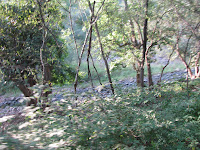We leave for the park at 6:40am. This morning we are on track 4. It is a crisp cool morning, great for tiger hunting. We drive slowly listening and looking for signs of a tiger. There is very little activity this morning and for the first 45 minutes we only see a few birds lounging around the lake.
 |
| Kingfisher |
 |
| Indian Snake Bird |
Just past the lake we encounter another vehicle. Their naturalist has seen a tiger. The hunt is on!!!! For the next 45 minutes we bounce up and down a 1km stretch of road stopping occasionally to listen for warning calls. We see and hear nothing but the chase is exhilarating. Eventually we meet up with the other vehicles on the track. They are all stopped 20 feet away from a bush. Our naturalist tells us there is a tiger in the bush. We park directly in front of the bush and wait. I find the scene amusing, 5 vehicles and 100 pairs of eyes staring at a bush where a man-eating tiger is supposedly hidden. With all of this human attention certainly no sensible tiger would come out of hiding. The typical American looking for instant gratification, I suggest to the woman next to me that perhaps someone should go into the brush to roust the tiger. The words barely leave my mouth when I see a pair of yellow eyes staring back at me. It's a tiger!! And she is about 5 feet away from me. I am so surprised I can barely breath. "Th..th..there she is," I stammer. She is beautiful. She gives us, her adoring fans, a look of utter disgust and irritation before she turns and saunters into the brush. I am so awed by her presence that I almost forget to take a picture. The sight of her brings me to tears.
 |
| You can barely see the stripes in the middle of the photo. |
SHE is T6, Machli, otherwise known as The Lady of the Lake and she is quite famous. She is the most photographed tiger in the world. She has her own Facebook page and has been the subject of several documentaries. She is one of the oldest tigers in Ranthambore at around 15 years of age. She is the mother of 11 cubs. She is old and missing several teeth (she lost 3 protecting a cub from a crocodile). She has turned her former hunting grounds over to her daughters. It is expected that she will not live much longer so to see her is an honor and a privilege.
The remainder of the morning passes uneventfully (how can you top tiger royalty?) with the exception of the appearance of a rather frightened and flustered Indian hare.
I go back to the hotel to eat lunch and rest before my afternoon safari. Tiger hunting has left me tired and hungry.
At 2:45pm I am back in the park to tackle Track 5, home to 1 male and 2 female tigers. We see several herd of Spotted Deer. They look like Bambi.
We also encounter a group of black-faced Languor monkeys. I hate monkeys but at least this guys aren't terribly aggressive. They are kindof cute.
 |
| Check out the long tail |
 |
| Hear no evil, see no evil, speak no evil |
We stop often to listen for warning calls and drive slowly to look for tiger tracks. Finally, we find some tracks. They are fresh, only a few hours old and from a female tiger.
We briefly hunt for her but to no avail. The naturalist tells me later in private that it is too hot to see tigers this afternoon. They are all in the brush resting before the evening hunt.
We see no tigers this time but the views are fantastic.
The adventure ends for the day. Tomorrow I leave for Agra and the Taj Mahal but not before 1 more early morning chance to bag a tiger.
.JPG)
.JPG)


.JPG)
.JPG)



.JPG)









.JPG)

.JPG)
.JPG)






.JPG)

.JPG)











.JPG)





